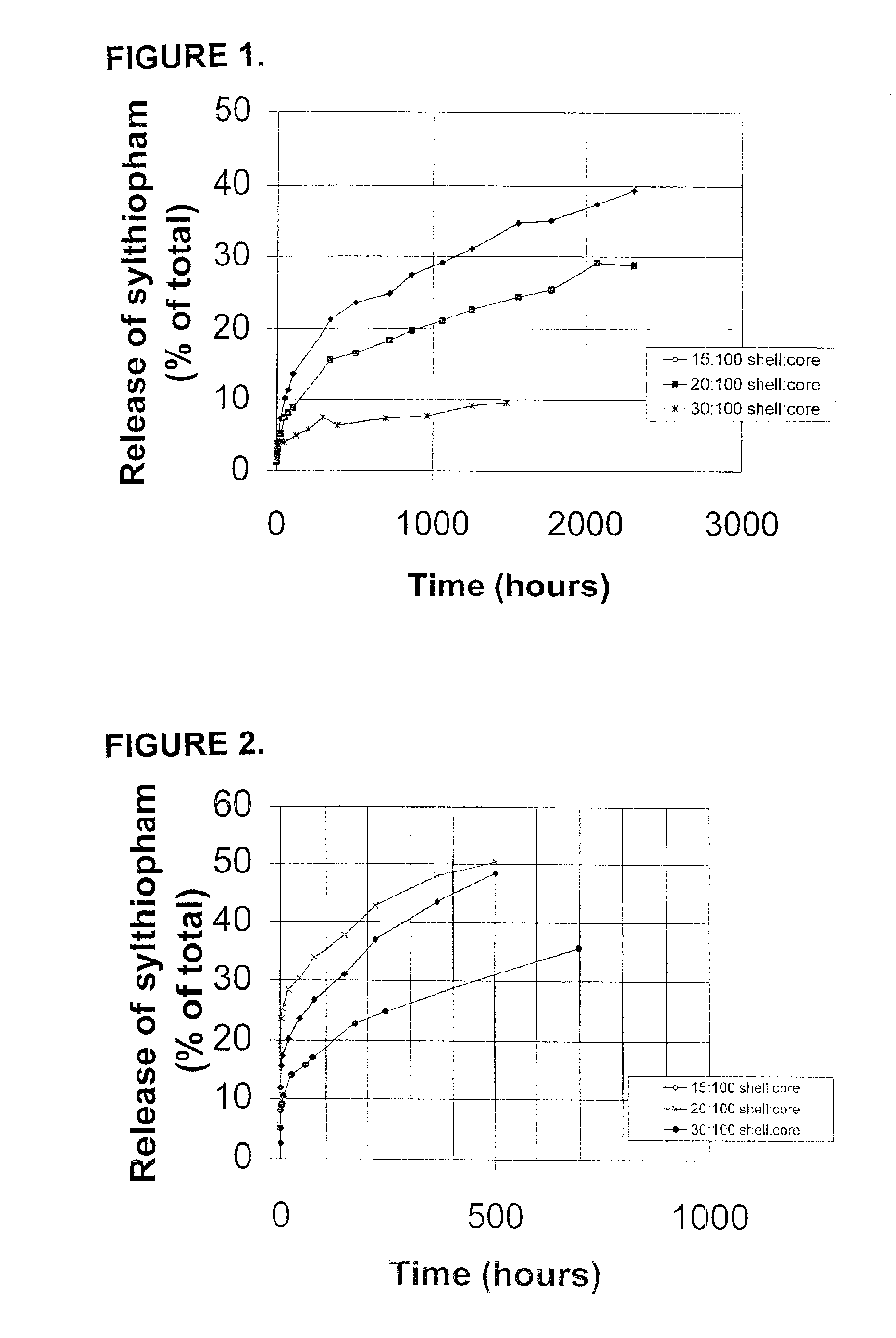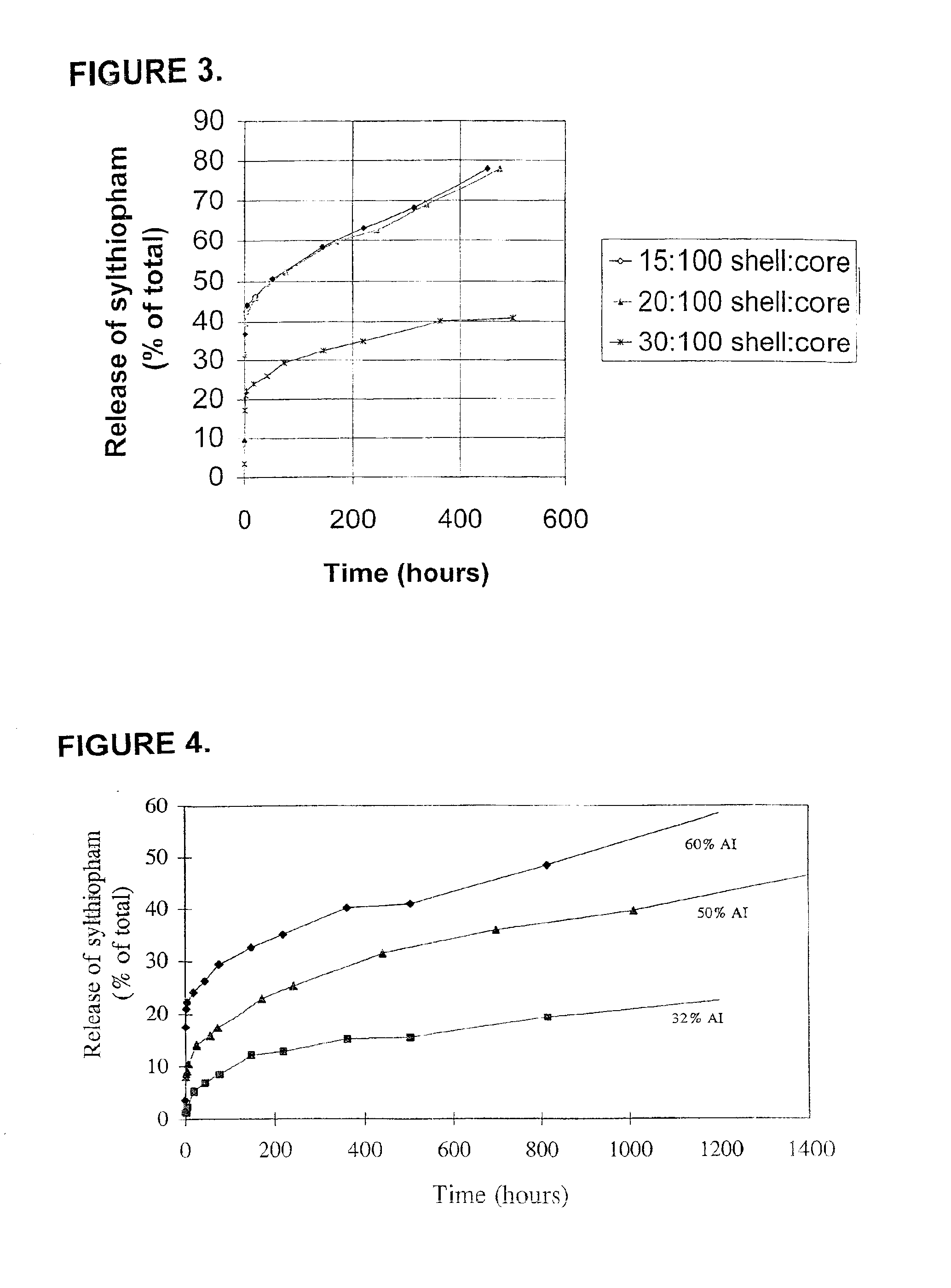Method of microencapsulating an agricultural active having a high melting point and uses for such materials
a technology of agricultural actives and microencapsulation, which is applied in the direction of heterocyclic compound active ingredients, biocide, drug compositions, etc., can solve the problems of unintended contact with plants and animals in streams, neighboring fields and homes, and the concentration of agricultural actives is reduced to below the efficacy level
- Summary
- Abstract
- Description
- Claims
- Application Information
AI Technical Summary
Benefits of technology
Problems solved by technology
Method used
Image
Examples
example 1
[0305]This example illustrates the production of microcapsules containing silthiopham as the agricultural active and with the use of a citric acid derivative as an organic solvent.
[0306]An aqueous solution of Lomar D surfactant (5.16 g; available from Henkel Corp., Morristown, N.J.) was prepared in 90.4 g water in a 250 ml beaker. The pH of the solution was adjusted to 7.2 by adding a small amount of citric acid, and the solution was heated to 55° C. An organic liquid solution was prepared by intermixing silthiopham (N-allyl-4,5-dimethyl-2-trimethylsilylthiophene-3-carboxamide, 16.00 g, available from Monsanto Company, St. Louis, Mo.), acetyltri-n-butyl-citrate (34.0 g; available as Citroflex A-4 from Morflex, Inc., Greensboro, N.C.), Desmodur N 3,200 (7.23 g; an aliphatic polyisocyanate (tri-isocyanate) based on hexamethylene diisocyanate, available from Bayer Corporation, Pittsburgh, Pa.) and meta-tetramethylenexylylene diisocyanate (TMXDI) (2.37 g; available from Miles Laboratori...
example 2
[0307]This example illustrates the production of microcapsules containing silthiopham having thinner shells than in Example 1.
[0308]An aqueous solution of Lomar D (5.16 g) was added to 90.4 g water in a 250 ml beaker, and the pH of the solution was adjusted to 7.2 by adding a small amount of citric acid and the solution was heated to 55° C. An organic solution was prepared by intermixing silthiopham (16.00 g), Citroflex A-4 (34.0 g), Desmodur N 3,200 (4.82 g) and TMXDI (1.58 g) and then heating the mixture until all of the solids dissolved and the temperature of the solution was maintained at 50°-55° C. The aqueous solution was agitated with a Silverson S4RT-4 mixer equipped with a six hole screen for 5-10 seconds at 4,200 rpm and the organic solution was added to the agitated solution in 20 seconds. The mixture was further agitated at 9,500 to 10,200 rpm for 40 seconds. After the formed emulsion was transferred into a 400 ml beaker equipped with a mechanic stirrer set at 625 rpm, a...
example 3
[0309]This illustrates the formation of microcapsules containing a higher level of silthiopham in the core.
[0310]An aqueous solution of Lomar D (5.16 g) was prepared by adding the surfactant to 90.4 g water in a 250 ml beaker. The pH of the solution was adjusted to 7.2 by adding a small amount of citric acid and heated to 55° C. An organic solution was prepared by mixing silthiopham (16.00 g), Citroflex A-4 (34.0 g), Desmodur N 3,200 (7.23 g) and TMXDI (2.37 g) together and then heating the mixture until all of the solids were dissolved and the temperature of the solution was maintained at 50°-55° C. The aqueous solution was agitated with a Silverson S4RT-4 mixer equipped with a six hole screen for 5-10 seconds at 4,200 rpm and the organic solution was added into the agitated solution in 20 seconds. The mixture was further agitated at 9,500 to 10,200 rpm for 40 seconds. After the formed emulsion was transferred into a 400 ml beaker equipped with a mechanic stirrer set at 625 rpm, an...
PUM
| Property | Measurement | Unit |
|---|---|---|
| melting point | aaaaa | aaaaa |
| melting point | aaaaa | aaaaa |
| melting point | aaaaa | aaaaa |
Abstract
Description
Claims
Application Information
 Login to View More
Login to View More - R&D
- Intellectual Property
- Life Sciences
- Materials
- Tech Scout
- Unparalleled Data Quality
- Higher Quality Content
- 60% Fewer Hallucinations
Browse by: Latest US Patents, China's latest patents, Technical Efficacy Thesaurus, Application Domain, Technology Topic, Popular Technical Reports.
© 2025 PatSnap. All rights reserved.Legal|Privacy policy|Modern Slavery Act Transparency Statement|Sitemap|About US| Contact US: help@patsnap.com



